Bones Study guides, Class notes & Summaries
Looking for the best study guides, study notes and summaries about Bones? On this page you'll find 28584 study documents about Bones.
Page 4 out of 28.584 results
Sort by
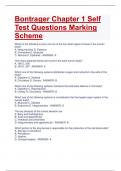
-
Bontrager Chapter 1 Self Test Questions Marking Scheme
- Exam (elaborations) • 16 pages • 2023
-
- $11.49
- 1x sold
- + learn more
Bontrager Chapter 1 Self Test Questions Marking Scheme Which of the following is (are) not one of the four basic types of tissue in the human body? A. Integumentary D. Osseous B. Connective E. Muscular C. Nervous F. Epithelial - ANSWER- A How many separate bones are found in the adult human body? A. 180 C. 206 B. 243 D. 257 - ANSWER- C Which one of the following systems distributes oxygen and nutrients to the cells of the body? A. Digestive C. Skeletal B. Circulatory D. Urinary...
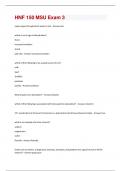
-
HNF 150 MSU Exam 3 Questions And Answers Rated A+ New Update Assured Satisfaction
- Exam (elaborations) • 11 pages • 2024
- Available in package deal
-
- $7.39
- 2x sold
- + learn more
major organ through which water is lost - Answer skin which is not a sign of dehydration? thirst increased urination shock pale skin - Answer increased urination which of the following is not a good source of zinc? milk beef shellfish potatoes poultry - Answer potatoes What impairs iron absorption? - Answer phyates which of the following is associated with increased iron absorption? - Answer vitamin C T/F: acceleration of Ca losses from bones is a potential result of low potassium ...
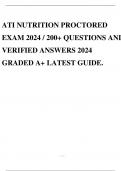
-
ATI NUTRITION PROCTORED EXAM 2024 / 200+ QUESTIONS AND VERIFIED ANSWERS 2024 GRADED A+ LATEST GUIDE.
- Exam (elaborations) • 58 pages • 2024
-
- $12.49
- 2x sold
- + learn more
ATI NUTRITION PROCTORED EXAM 2024 / 200+ QUESTIONS AND VERIFIED ANSWERS 2024 GRADED A+ LATEST GUIDE. 2 / 12 1. How many calories do carbs provide?: 4 cal/g 2. How many calories do fats provide?: 9 cal/g 3. How many calories do proteins provide?: 4 cal/g 4. Glucose: 70-1155. Albumin: 3.5-5.0 6. Prealbumin: 15-36 7. Protein: 6-8 8. Sodium: 135-145 9. Potassium: 3.5-5.010. Calcium: 9.0-10.5 11. Magnesium: 1.3-2.1 12. Platelets: 150,000-400,000 13. Hemoglobin: 12-18 14. Hematocrit: ...
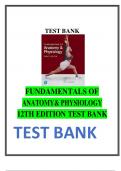
-
Fundamentals of Anatomy & Physiology 12th Edition TEST BANK ISBN- 978-0137953776 by Frederic Martini , Judi Nath , Edwin Bartholomew Latest Verified Review 2024 Practice Questions and Answers for Exam Preparation, 100% Correct with Explanations, Highly R
- Exam (elaborations) • 2229 pages • 2024
-
- $22.99
- 2x sold
- + learn more
Fundamentals of Anatomy & Physiology 12th Edition TEST BANK ISBN- 978-0137953776 by Frederic Martini , Judi Nath , Edwin Bartholomew Latest Verified Review 2024 Practice Questions and Answers for Exam Preparation, 100% Correct with Explanations, Highly Recommended, Download to Score A+ Fundamentals of Anatomy & Physiology 12th Edition Test Bank Contents 1. An Introduction to Anatomy and Physiology 2. The Chemical Level of Organization 3. The Cellular Level of Organization 4. The Tissue L...
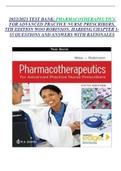
-
2022/2023 TEST BANK; PHARMACOTHERAPEUTICS FOR ADVANCED PRACTICE NURSE PRESCRIBERS, 5TH EDITION WOO ROBINSON.COVERING CHAPTERS 1-55 QUESTIONS AND ANSWERS WITH RATIONALES
- Exam (elaborations) • 250 pages • 2023
-
Available in package deal
-
- $13.00
- 136x sold
- + learn more
Pharmacotherapeutics for Advanced Practice Nurse Prescribers, 5th Edition Woo Robinson Test Bank offers rationale rich content for students to provide safe and effective medications and a thorough understanding of most relevant side effects and precautions when diagnosing, prescribing, and treating patients. These questions will challenge students to implement patient monitoring, teaching, and educating while providing the foundations to successfully understand course content. PHARMACOTHERAPE...
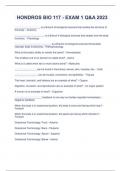
-
HONDROS BIO 117 - EXAM 1 Q&A 2023
- Exam (elaborations) • 5 pages • 2023
-
Available in package deal
-
- $12.99
- 2x sold
- + learn more
___________________ is a Branch of biological sciences that studies the structure of the body. - Anatomy ______________________ is a Branch if biological sciences that studies how the body functions. - Physiology ___________________________ is a Branch of biological sciences that studies improper body functioning. - Pathophysiology What is the body's ability to remain the same? - Homeostasis The smallest unit of an element is called what? - atoms What is it called when two or mor...
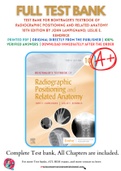
-
Test bank For Bontrager's Textbook of Radiographic Positioning and Related Anatomy 10th Edition by John Lampignano; Leslie E. Kendrick 9780323749565 Chapter 1-20 Complete Guide A+
- Exam (elaborations) • 357 pages • 2022
-
- $24.43
- 3x sold
- + learn more
Test bank For Bontrager's Textbook of Radiographic Positioning and Related Anatomy 10th Edition by John Lampignano; Leslie E. Kendrick 9565, 9 ,6548, 6 1. Terminology, Positioning, and Imaging Principles 2. Chest 3. Abdomen 4. Upper Limb 5. Humerus and Shoulder Girdle 6. Lower Limb 7. Femur and Pelvic Girdle 8. Cervical and Thoracic Spine 9. Lumbar Spine, Sacrum, and Coccyx 10. Bony Thorax—Sternum and Ribs 11. Cranium, Facial Bones, and Paranasal Sinuses 12...
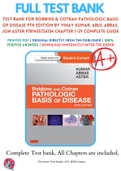

-
Test Bank For Robbins & Cotran Pathologic Basis of Disease 9th Edition By Vinay Kumar, Abul Abbas, Jon Aster 9781455726134 Chapter 1-29 Complete Guide .
- Exam (elaborations) • 155 pages • 2023
-
- $26.38
- 2x sold
- + learn more
Test Bank For Robbins & Cotran Pathologic Basis of Disease 9th Edition By Vinay Kumar, Abul Abbas, Jon Aster 6134, 3 . 6134, 3885, 6 1 The Cell as a Unit of Health and Disease 2 Cellular Responses to Stress and Toxic Insults: Adaptation, Injury, and Death 3 Inflammation and Repair 4 Hemodynamic Disorders, Thromboembolic Disease, and Shock 5 Genetic Disorders 6 Diseases of the Immune System 7 Neoplasia 8 Infectious Diseases 9 Environmental and Nutritional Diseases 10...
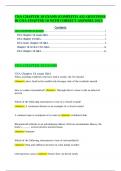
-
CNA CHAPTER 18 EXAMS (COMPLETE) ALL QUESTIONS IN CNA CHAPTER 18 WITH CORRECT ANSWERS (Newest 2024/2025)
- Exam (elaborations) • 40 pages • 2023
-
Available in package deal
-
- $12.50
- 1x sold
- + learn more
CNA CHAPTER 18 EXAMS (COMPLETE) ALL QUESTIONS IN CNA CHAPTER 18 WITH CORRECT ANSWERS (Newest 2024/2025) Contents CNA CHAPTER 18 EXAMS 1 CNA Chapter 18 exam Q&A 1 CNA chapter 18 Q&A 5 CNA exam -chapter 18 Q&A 8 Chapter 18 review CNA Q&A 18 CNA Chapter 18 Q&A 34 CNA CHAPTER 18 EXAMS CNA Chapter 18 exam Q&A When assisting residents who have had a stroke, the NA should {Answer:- place food in the unaffected/stronger side of the residents mouth How is scabies transmitted? {Answer...
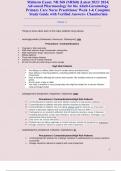
-
Midterm Exam: NR 568 (NR568) |Latest 2023/ 2024| Advanced Pharmacology for the Adult-Gerontology Primary Care Nurse Practitioner Week 1-4| Complete Study Guide with Verified Answers- Chamberlain
- Exam (elaborations) • 21 pages • 2023
-
Available in package deal
-
- $11.99
- 2x sold
- + learn more
Midterm Exam: NR 568 (NR568) |Latest 2023/ 2024| Advanced Pharmacology for the Adult-Gerontology Primary Care Nurse Practitioner Week 1-4| Complete Study Guide with Verified Answers- Chamberlain Week 1 Things to know about each of the major antibiotic drug classes - Aminoglycosides (Gentamicin, Neomycin, Tobramycin) ‘icin Precautions / Contraindications Pregnancy: fetal ototoxicity With other ototoxic drugs: furosemide, minocycline With nephrotoxic drugs: vancomycin, cis...

Study stress? For sellers on Stuvia, these are actually golden times. KA-CHING! Earn from your study resources too and start uploading now. Discover all about earning on Stuvia


